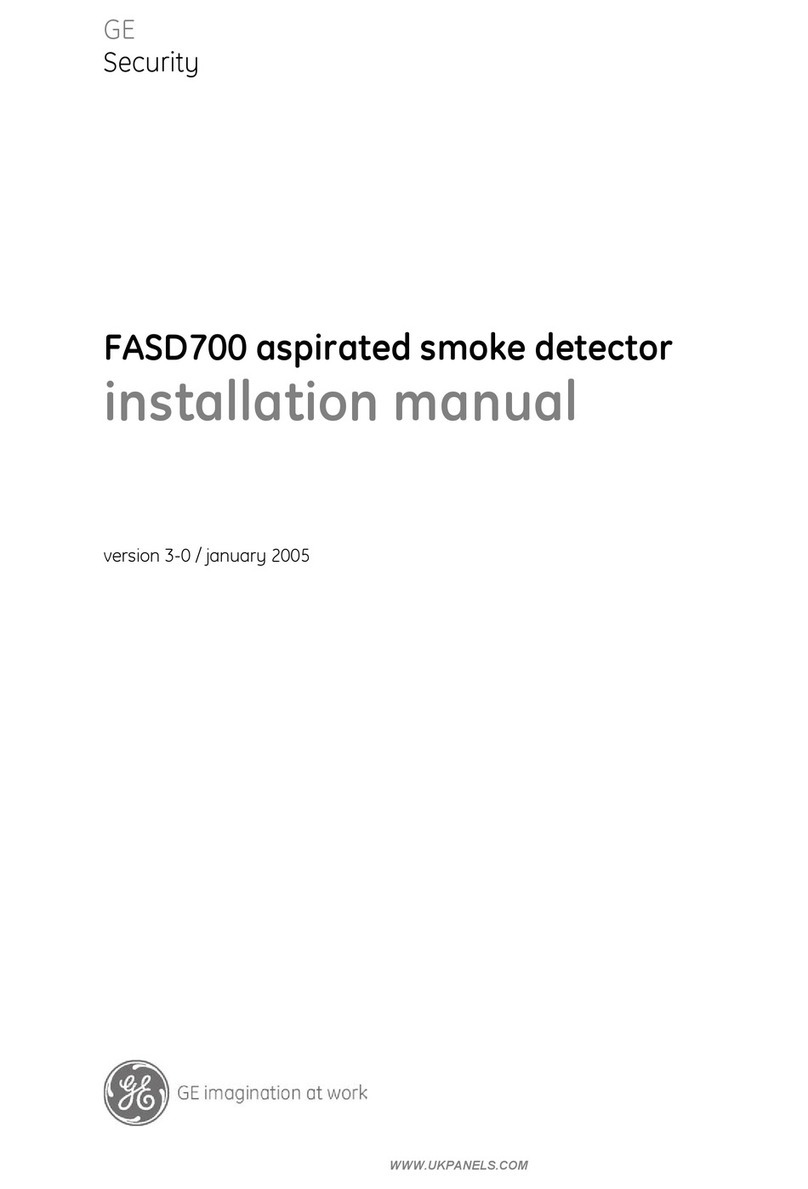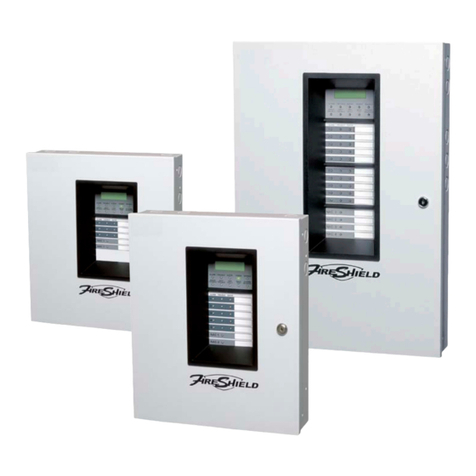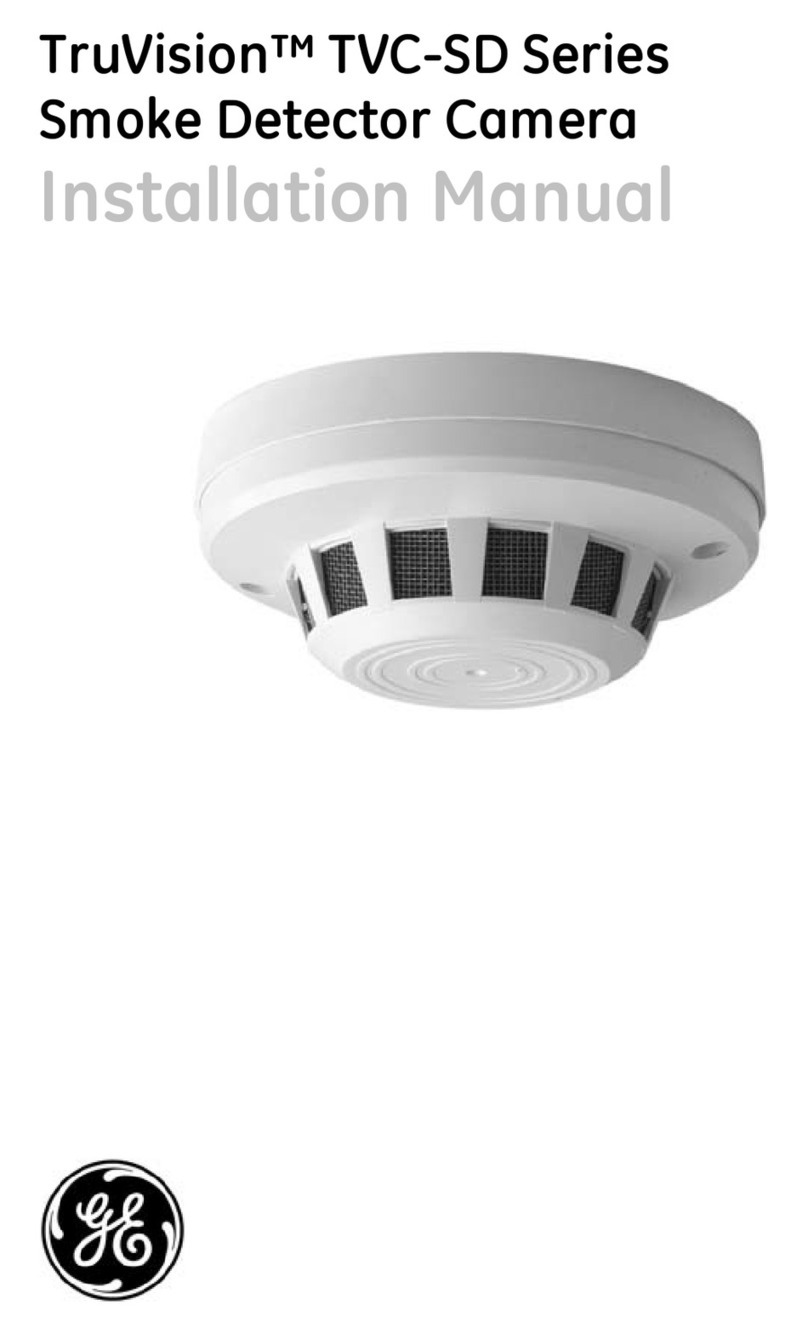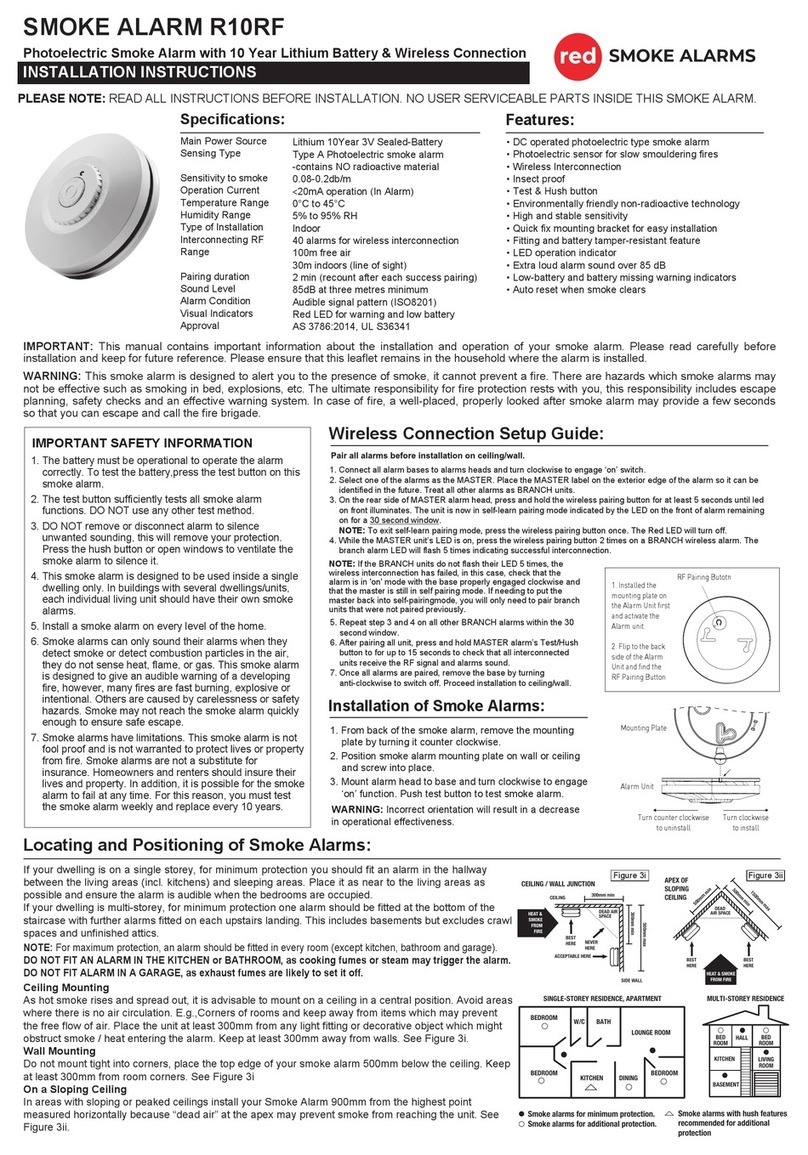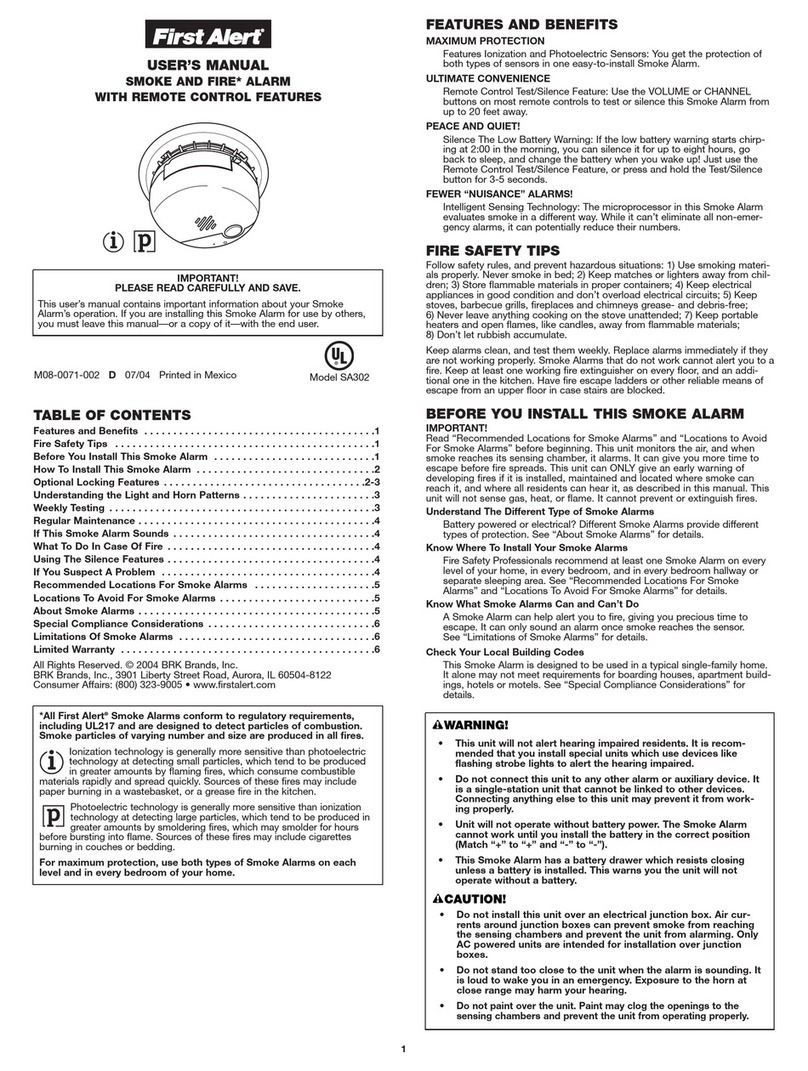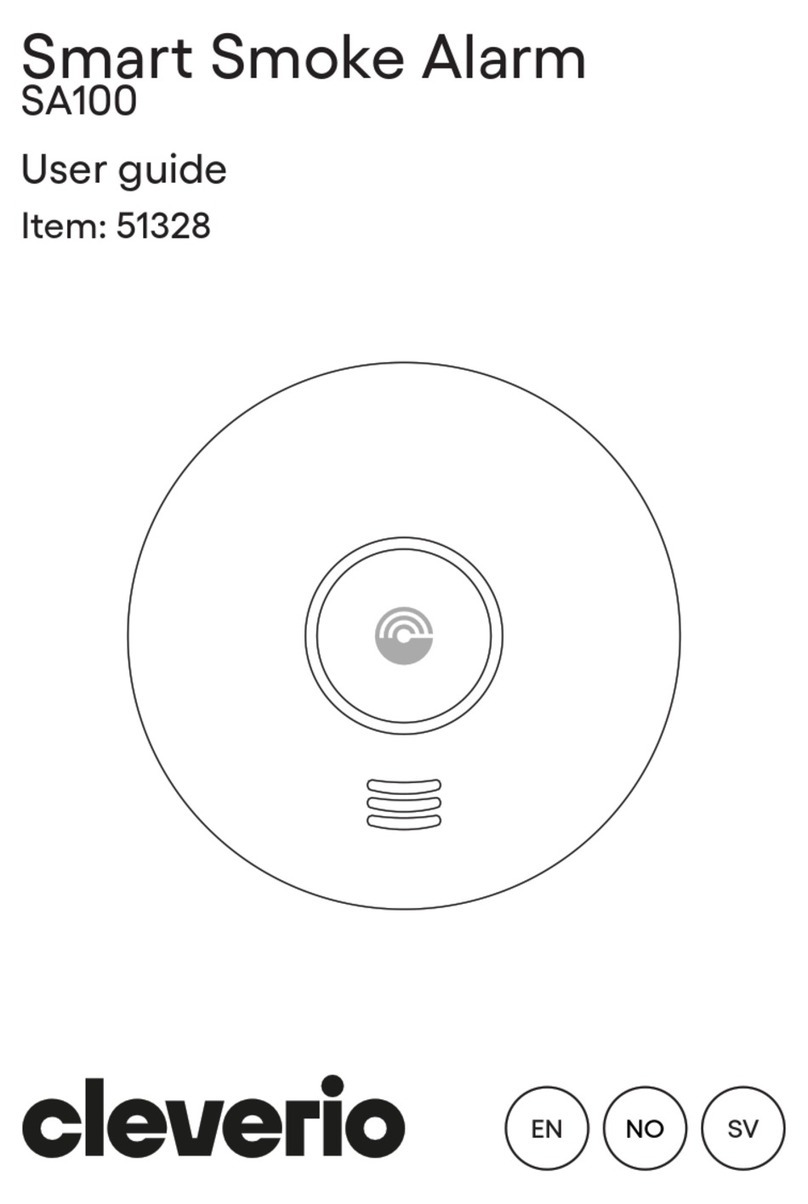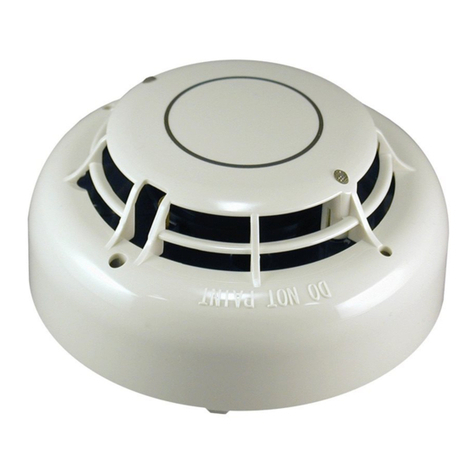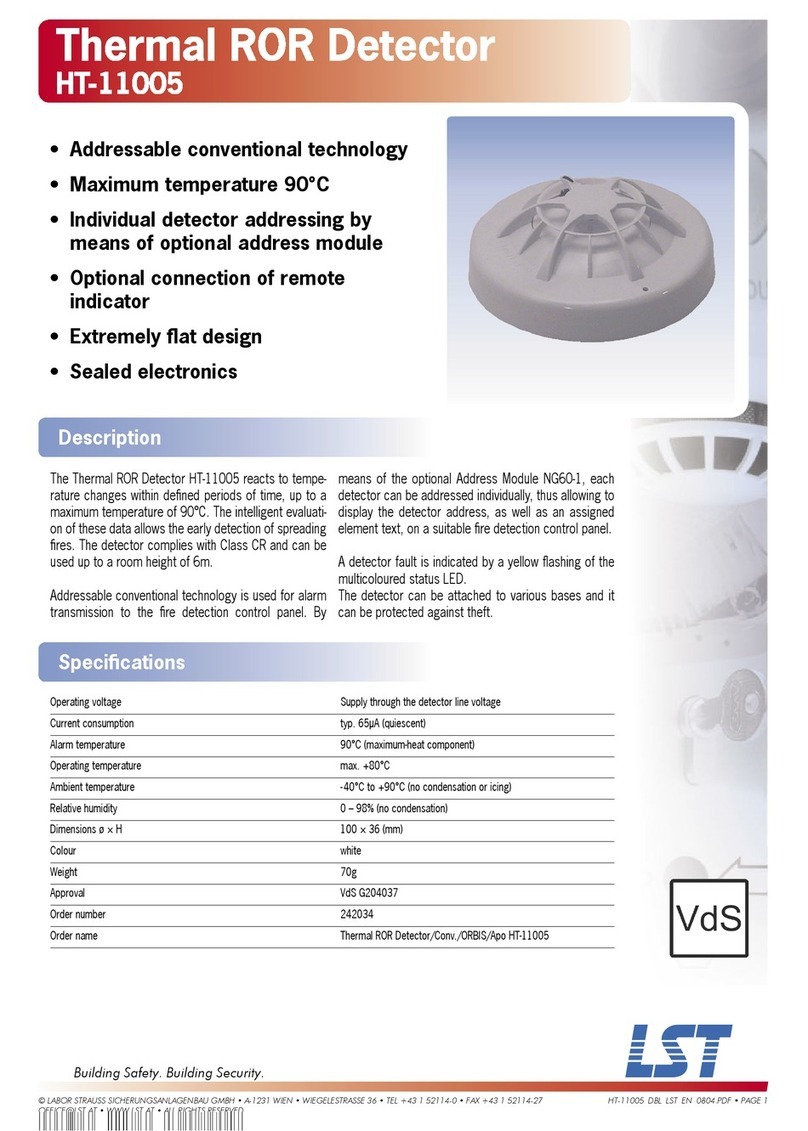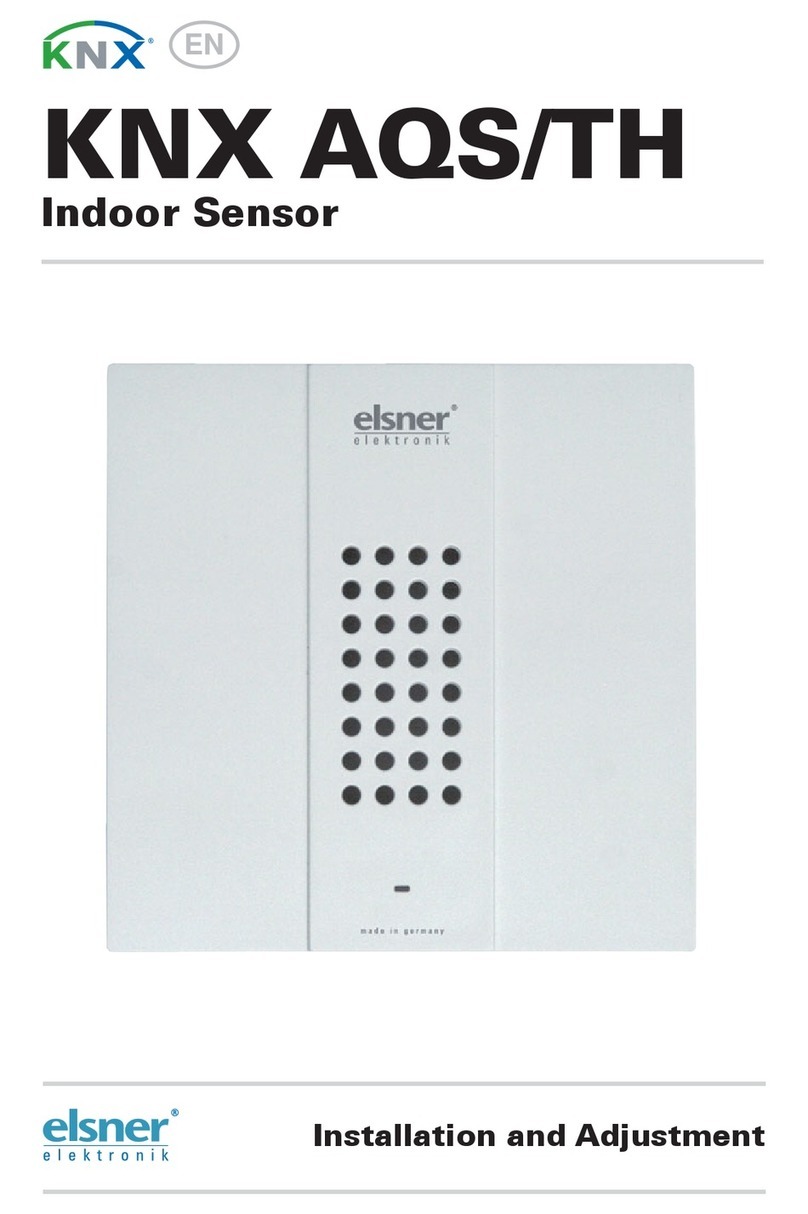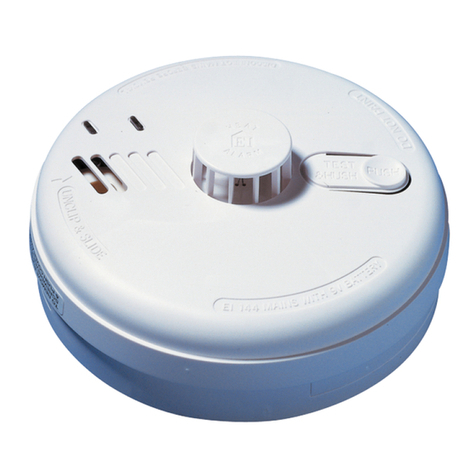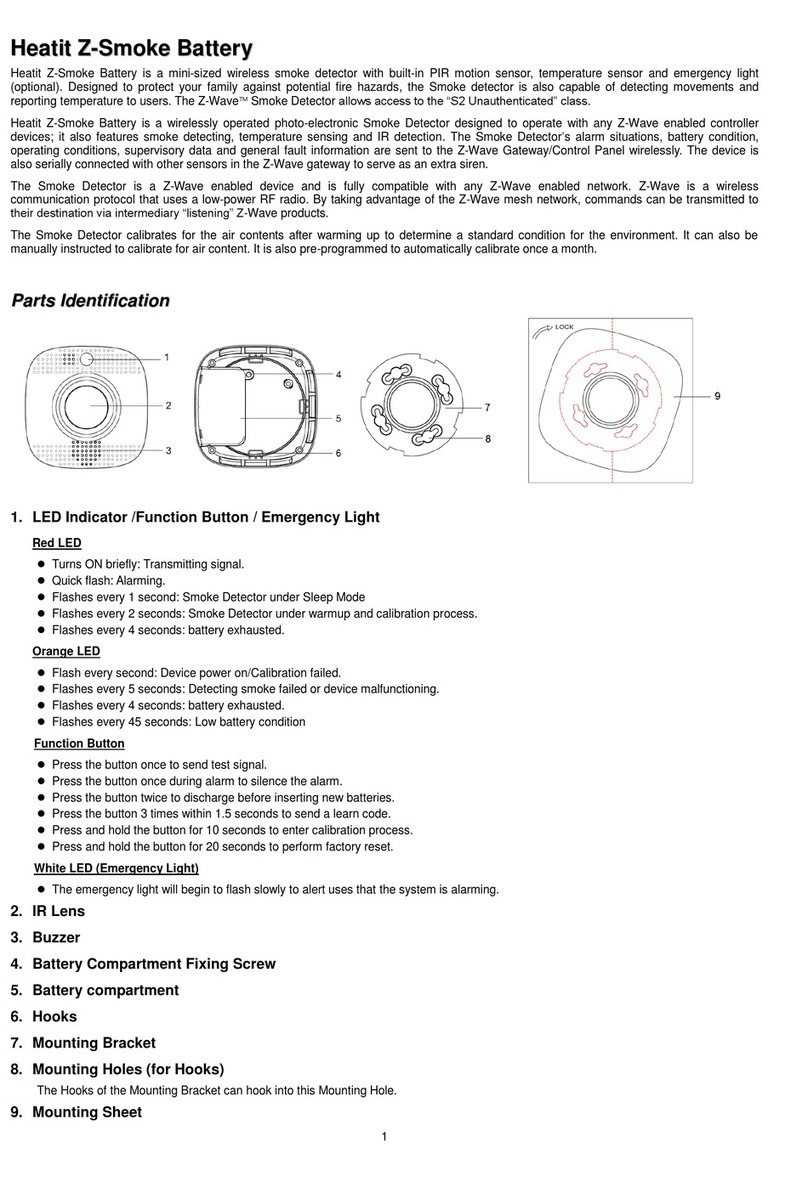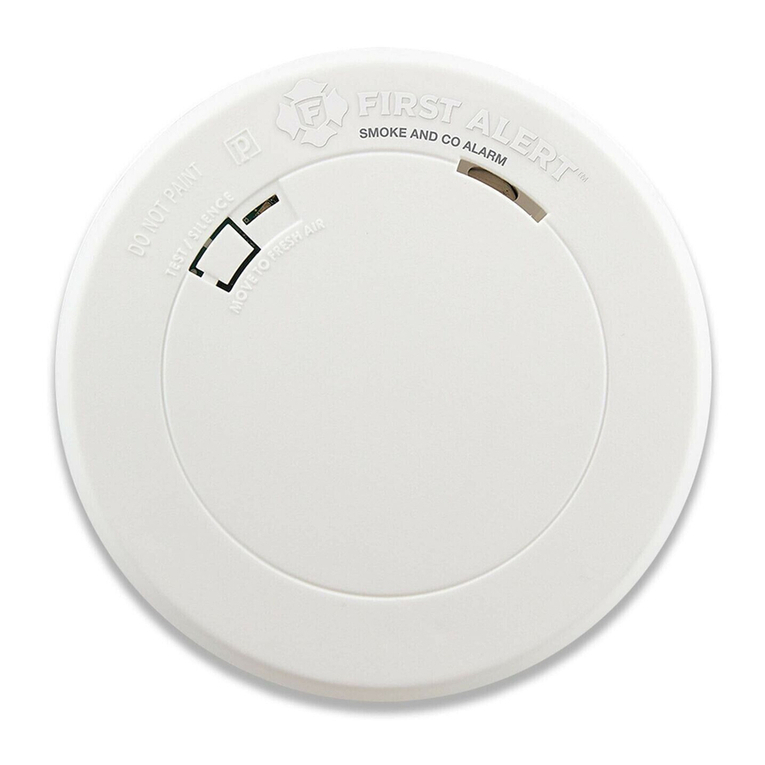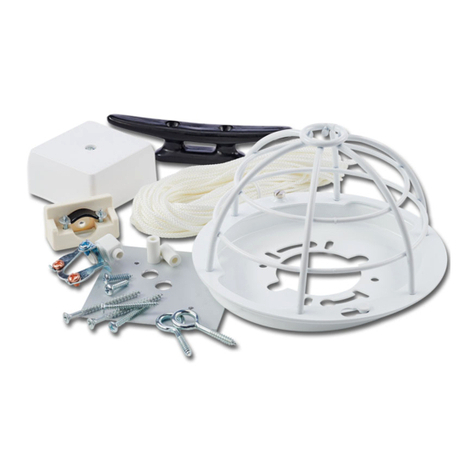GE Security Vigilant VS1 Product manual

GE
Security
P/N 3101113 • REV 4.0 • ISS 02MAR10
Vigilant VS1 and VS2 Technical
Reference Manual

Copyright
© 2010 GE Security, Inc.
This document may not be copied in whole or in part or
otherwise reproduced without prior written consent from
GE Security, Inc., except where specifically permitted under
US and international copyright law.
Disclaimer
The information in this document is subject to change
without notice. GE Security, Inc. (“GE Security”) assumes no
responsibility for inaccuracies or omissions and specifically
disclaims any liabilities, losses, or risks, personal or
otherwise, incurred as a consequence, directly or indirectly,
of the use or application of any of the contents of this
document. For the latest documentation, contact your local
supplier or visit us online at www.gesecurity.com.
This publication may contain examples of screen captures
and reports used in daily operations. Examples may include
fictitious names of individuals and companies. Any
similarity to names and addresses of actual businesses or
persons is entirely coincidental.
Trademarks and patents
GE and the GE monogram are trademarks of General
Electric Company. The Vigilant VS1 and VS2 name and logo
are trademarks of GE Security.
Other trade names used in this document may be
trademarks or registered trademarks of the manufacturers
or vendors of the respective products.
Intended use
Use this product only for the purpose it was designed for;
refer to the data sheet and user documentation for details.
For the latest product information, contact your local
supplier or visit us online at www.gesecurity.com.
FCC compliance
This equipment has been tested and found to comply with
the limits for a Class A digital device, pursuant to part 15 of
the FCC Rules. These limits are designed to provide
reasonable protection against harmful interference when
the equipment is operated in a commercial environment.
This equipment generates, uses, and can radiate radio
frequency energy and, if not installed and used in
accordance with the instruction manual, may cause
harmful interference to radio communications.
You are cautioned that any changes or modifications not
expressly approved by the party responsible for compliance
could void the user’s authority to operate the equipment.
Manufacturer
GE Security, Inc.
HQ and regulatory responsibility:
GE Security, Inc., 8985 Town Center Parkway, Bradenton, FL
34202, USA
EU authorized manufacturing representative:
GE Security B.V., Kelvinstraat 7, 6003 DH Weert, The
Netherlands

Vigilant VS1 and VS2 Technical Reference Manual i
Content
Important information v
Minimum system requirements viii
To get started ix
Chapter 1 Installation and wiring 1
Cabinet box installation 2
Panel electronics installation 3
Cabinet wire routing 4
AC power wiring 5
Panel low voltage wiring 6
Battery wiring (TB8) 7
Notification appliance circuit wiring (TB2) 8
Device loop wiring 11
Alarm, trouble, and supervisory relay wiring (TB3) 13
Remote annunciator wiring (TB4) 14
Auxiliary/smoke power output wiring (TB3) 16
SA-DACT wiring 18
SA-232 wiring 20
SA-CLA wiring 22
SA-ETH wiring 24
CTM module wiring 25
RPM module wiring 26
Chapter 2 Front panel programming 29
UL 864 programming requirements 31
Getting started 32
Device type descriptions 41
Displaying the Program menu 45
Setting the time and date 46
Setting daylight saving time 47
Changing the passwords 49
Restoring the factory default settings 49
Setting up the programmable keys 51
Clearing the event history log 54
Restarting the panel 55
Enabling RS232 communication 55
Auto programming the panel 56
Performing incremental programming 64
Adding and removing devices from programmed systems 67
Advanced programming 76

ii Vigilant VS1 and VS2 Technical Reference Manual
Chapter 3 System operation 129
Operation overview 131
LCD display screen 132
System LEDs 136
LED display expander LEDs 137
Control buttons 138
Component descriptions 143
Events with event messages 144
Event ID numbers and descriptions 146
Viewing event details 151
Resetting the panel 151
Silencing panel and annunciator buzzers 152
Silencing notification appliances 152
Conducting a lamp test 154
Activating and restoring output devices 154
Unlatching latched output devices 155
Activating and restoring panel NACs 156
Disabling and enabling devices 156
Disabling and enabling zones 158
Disabling and enabling panel events 159
Disabling and enabling loop events 160
Disabling and enabling panel NACs 162
Disabling and enabling the dialer and network 163
Initiating a fire drill 163
Conducting a walk test 164
Chapter 4 Reports 167
Basic steps for viewing and printing reports 168
History report 168
Walk Test report 170
Device Maintenance report 170
System Status report 171
Correlation Groups report 172
Correlation Group Configuration report 172
Zone report 173
System Configuration report 173
Internal Status report 174
Device Details report 175
Diagnostics reports 176
Internal Fault report 177
Canceling a report 178

Vigilant VS1 and VS2 Technical Reference Manual iii
Chapter 5 Diagnostics, maintenance, and testing 179
Preventive maintenance schedule 180
Fast ground check 180
Recalibrate device 181
Loop comm check 181
Control panel testing 183
Testing a device (test fire) 184
SA-DACT testing 184
Conducting a lamp test 185
Starting and stopping a walk test 186
Using HyperTerminal 188
Replacing a device in alarm 190
Appendix A Panel specifications 191
Control panel specifications 192
Appendix B Worksheets 195
Battery calculation worksheet 196
Notification appliance circuit calculations worksheet 199
Notification appliance voltage drop calculation worksheet 205
Device loop maximum wire length worksheet 206
Correlation groups worksheet 212
Device settings worksheet 213
Loop worksheet 215
Panel configuration worksheet 216
Panel operation worksheet 219
Zone settings worksheet 220
Appendix C Front panel menu flowcharts 223
Main menu 224
Reports menu (1 of 2) 225
Reports menu (2 of 2) 226
Test menu 227
Control menu 228
Program menu 229
Program: Programmable Keys menu 230
Advanced Program menu 231
Advanced Program: Loop Configuration menu 232
Advanced Program: Correlation Groups menu 233
Advanced Program: Loop Configuration — Device menu 234
Advanced Program: Panel Configuration menu 235
Advanced Program: Panel Configuration — CMS Device menu 236
Advanced Program: Panel Operation menu 237

iv Vigilant VS1 and VS2 Technical Reference Manual
Advanced Program: Panel Events menu 238
Advanced Program: Loop Events menu 239
Advanced Program: Unconfigured Alarm menu 240
Advanced Program: Common Trouble menu 240
Auto Program command menu flow 241
Incremental Program menu 242
Diagnostics menu 243
Appendix D Applications 245
Local alarm signaling applications 246
Correlated zone and system alarm signaling applications 247
In-suite signal silence applications 252
Appendix E Device types to personality codes correlation 257
Index 265

Vigilant VS1 and VS2 Technical Reference Manual v
Important information
Limitation of liability
This product has been designed to meet the requirements of NFPA 72 National Fire
Alarm Code, UL 864 Standard for Control Units for Fire Protective Signaling Systems,
and ULC S527 Standard for Control Units for Fire Alarm Systems. Installation in
accordance with this manual, applicable codes, and the instructions of the authority
having jurisdiction is mandatory. GE Security shall not under any circumstances be
liable for any incidental or consequential damages arising from loss of property or
other damages or losses owing to the failure of GE Security products beyond the cost
of repair or replacement of any defective products. GE Security reserves the right to
make product improvements and change product specifications at any time.
While every precaution has been taken during the preparation of this manual to
ensure the accuracy of its contents, GE Security assumes no responsibility for errors
or omissions.
FCC compliance statement
This equipment can generate and radiate radio frequency energy. If the equipment is
not installed in accordance with this manual, it may cause interference to radio
communications. This equipment has been tested and found to comply with the limits
for Class A computing devices pursuant to Subpart B of Part 15 of the FCC Rules.
These rules are designed to provide reasonable protection against such interference
when this equipment is operated in a commercial environment. Operation of this
equipment is likely to cause interference, in which case the user, at his own expense,
will be required to take whatever measures may be required to correct the
interference.
SA-DACT FCC information
Cautions
• To ensure proper operation, this dialer must be installed according to the
enclosed installation instructions. To verify that the dialer is operating properly
and can successfully report an alarm, it must be tested immediately after
installation, and periodically thereafter, according to the enclosed test
instructions.
• In order for the dialer to be able to seize the phone line to report an alarm or other
event when other customer equipment (telephone, answering system, computer
modem, etc.) connected to the same line is in use, the dialer must be connected to

vi Vigilant VS1 and VS2 Technical Reference Manual
a properly installed RJ-31X jack. The RJ-31X jack must be connected in series with,
and ahead of, all other equipment attached to the same phone line. Series
installation of an RJ-31X jack is depicted in the wiring diagram. If you have any
questions concerning these instructions, you should consult your telephone
company or a qualified installer.
Testing
When programming emergency numbers or making test calls to emergency
numbers, remain on the line and briefly explain to the dispatcher the reason for the
call. Perform programming and testing activities in the off-peak hours, such as early
morning or late evenings.
Compliance
• For equipment approved before July 23, 2001: This dialer complies with Part 68
of the FCC rules. A label attached to the dialer contains, among other information,
the FCC registration number and ringer equivalence number (REN) for this
equipment. If requested, this information must be provided to the telephone
company.
For equipment approved after July 23, 2001: This dialer complies with Part 68 of
the FCC rules and the requirements adopted by the Administrative Council for
Terminal Attachments (ACTA). A label attached to the dialer contains, among
other information, a product identifier in the format US:AAAEQ##TXXXX. If
requested, this information must be provided to the telephone company.
• The plug and jack used to connect the dialer to the premises wiring and telephone
network must comply with the applicable FCC Part 68 rules and requirements
adopted by ACTA. The dialer must be connected to a compliant RJ-31X or RJ-38X
jack using a compliant cord. If a modular telephone cord is supplied with the
dialer, it is designed to meet these requirements. See installation instructions for
details.
• A ringer equivalence number (REN) is used to determine how many devices you
can connect to a telephone line. If the total REN value for all devices connected on
a telephone line exceeds that allowed by the telephone company, the devices
may not ring on an incoming call. In most (but not all) areas the total REN value
should not exceed 5.0. To be certain of the total REN value allowed on a telephone
line, contact the local telephone company.
For products approved after July 23, 2001, the REN is part of the product identifier
in the format US:AAAEQ##TXXXX. The digits ## represent the REN without a
decimal point. Example: 03 is an REN of 0.3. For earlier products the REN is listed
separately.

Vigilant VS1 and VS2 Technical Reference Manual vii
• If the dialer is harming the telephone network, the telephone company will notify
you in advance that temporary discontinuance of service may be required. If
advance notice isn’t practical, the telephone company will notify you as soon as
possible. You will also be advised of your right to file a complaint with the FCC, if
you believe it is necessary.
• The telephone company may make changes to its facilities, equipment,
operations, or procedures that could affect the operation of the dialer. If this
happens, the telephone company will provide advance notice in order for you to
make necessary modifications to maintain uninterrupted service.
• If you are experiencing problems with the dialer, contact the manufacturer for
repair or warranty information. If the dialer is harming the telephone network, the
telephone company may request that you disconnect the dialer until the problem
is resolved.
• The dialer contains no user serviceable parts. In case of defects, return the dialer
for repair.
• You may not connect the dialer to a public coin phone or a party line service
provided by the telephone company.
Industry Canada information
Note: The Industry Canada label identifies certified equipment. This certification
means that the equipment meets certain telecommunications network protective,
operational, and safety requirements. Industry Canada does not guarantee the
equipment will operate to the user’s satisfaction.
Before installing this equipment, users should ensure that it is permissible to be
connected to the facilities of the local telecommunications company. The equipment
must also be installed using an acceptable method of connection. The customer
should be aware that compliance with the above conditions may not prevent
degradation of service in some situations.
Repairs to certified equipment should be made by an authorized Canadian
maintenance facility designated by the supplier. Any repairs or alterations made by
the user to this equipment, or equipment malfunctions, may give the
telecommunications company cause to request the user disconnect the equipment.
Caution: Users should not attempt to make connections themselves, but should
contact the appropriate electrical inspection authority, or electrician, as appropriate.
Users should ensure for their own protection that the electrical ground connections
of the power utility, telephone lines, and internal metallic water pipe system, if

viii Vigilant VS1 and VS2 Technical Reference Manual
present, are connected together. This precaution may be particularly important in
rural areas.
Note: The Load Number (LN) assigned to each terminal device denotes the
percentage of the total load to be connected to a telephone loop that is used by the
device, to prevent overloading. The termination on a loop may consist of any
combination of devices subject only to the requirements that the sum of the Load
Numbers of all the devices does not exceed 100.
Minimum system requirements
The table below lists the minimum hardware requirements for each type of system
for which the control panel is listed.
Table 1: Minimum hardware requirements for applications
System Equipment needed
Protected Premises (Local) Fire Alarm System Control panel
Appropriately sized batteries
Auxiliary Fire Alarm System, Local Energy Type Control panel
Appropriately sized batteries
CTM module
Remote Supervising Station Fire Alarm System Control panel
Appropriately sized batteries
SA-DACT or RPM module
Central Station Fire Alarm System Control panel
Appropriately sized batteries
SA-DACT or RPM module

Vigilant VS1 and VS2 Technical Reference Manual ix
To get started
If you are just starting out, follow the items in this checklist to prepare, install, wire,
and program your fire alarm control panel.
1. Prepare the site. Make sure the installation location is free from construction dust
and debris and extreme temperature ranges and humidity.
2. Unpack the equipment.
3. Install the cabinet box. See “Cabinet box installation” on page 2 for cabinet
dimensions.
4. Install the panel electronics in the cabinet box. See “Panel electronics installation”
on page 3.
5. Remove the clear protective plastic from the front panel display.
6. Install the optional panel accessories. Refer to each component’s installation
sheet instructions.
7. Review Chapter 1 “Installation and wiring” starting on page 1.
WARNING: Make sure that the AC power circuit breaker is off before connecting
wires to the terminal block.
8. Connect the field wiring. Meter for opens, grounds, and shorts before connecting.
9. Connect AC power and ground wiring. See “AC power wiring” on page 5. The panel
cannot be started on batteries only.
10. Connect panel low voltage wiring. See “Panel low voltage wiring” on page 6.
11. Turn on AC power.
12. Connect the batteries. See “Battery wiring (TB8)” on page 7.
13. Program the panel. See Chapter 2 “Front panel programming” on page 29. If you
are using the configuration utility, refer to the online help.
14. Test the system for proper operation.

x Vigilant VS1 and VS2 Technical Reference Manual

Vigilant VS1 and VS2 Technical Reference Manual 1
Chapter 1
Installation and wiring
Summary
This chapter covers all control panel wiring, such as AC power, NACs, device loops,
and battery wiring.
Content
Cabinet box installation 2
Panel electronics installation 3
Cabinet wire routing 4
AC power wiring 5
Panel low voltage wiring 6
Battery wiring (TB8) 7
Notification appliance circuit wiring (TB2) 8
Device loop wiring 11
Alarm, trouble, and supervisory relay wiring (TB3) 13
Remote annunciator wiring (TB4) 14
Auxiliary/smoke power output wiring (TB3) 16
SA-DACT wiring 18
SA-232 wiring 20
SA-CLA wiring 22
SA-ETH wiring 24
Circuit specifications 24
CTM module wiring 25
RPM module wiring 26

Chapter 1: Installation and wiring
2 Vigilant VS1 and VS2 Technical Reference Manual
Cabinet box installation
The cabinet box can be surfaced mounted or semiflush mounted.
To surface mount the cabinet box:
1. Position the cabinet box on the finished wall surface.
2. Fasten the cabinet box to the wall surface where indicated.
To semiflush mount the cabinet box:
1. Frame the interior wall as required to support the full weight of the cabinet and
standby batteries.
2. Install a semiflush trim ring (optional) to the cabinet.
3. Fasten the cabinet box to the framing studs where indicated.
Figure 1: Surface and semiflush mounting details
S
ur
f
ace mount
S
emi
f
lush mount
Trim rin
g

Chapter 1: Installation and wiring
Vigilant VS1 and VS2 Technical Reference Manual 3
Figure 2: Cabinet backbox, backbox with door, and backbox with door and trim ring attached
D1
D2 D3
D4
D5
D6
Surface mounting holes
Semiflush mounting holes
S
ur
f
ace mounting holes
D8
D7
D9
Backbox with
door attached
Backbox with door an
d
trim ring attached
D9
Table 2: Backbox and backbox with door dimensions (in. and cm)
Model D1 [1] D2 D3 D4 D5 [1] D6 D7 D8 D9
VS1 21.50
(54.6)
3.85
(9.8)
7.5
(19)
15.50
(39.4)
14.25
(36.2)
10.25
(26.0)
4.9
(12.4)
23.6
(59.9)
2.7
(6.8)
VS2 28.0
(71.1)
3.85
(9.8)
9.0
(22.8)
22.0
(55.8)
15.75
(40.0)
10.25
(26.0)
4.9
(12.4)
30.1
(76.4)
2.7
(6.8)
[1] Add 1-1/2 in. (3.81 cm) to D1 and D5 dimensions for trim kit.
Panel electronics installation
The panel electronics must be installed in the cabinet box.
Note: Wait until the possibility of construction damage or vandalism has passed
before installing the panel electronics.

Chapter 1: Installation and wiring
4 Vigilant VS1 and VS2 Technical Reference Manual
Figure 3: Panel electronics installation
Cabinet wire routing
Using the diagram below, keep power-limited wiring in the shaded area and
nonpower-limited wiring in the unshaded area at all times.

Chapter 1: Installation and wiring
Vigilant VS1 and VS2 Technical Reference Manual 5
Figure 4: Cabinet wire routing
00:00:00 01/01/07
,
[1]
[1] Power-limited only when connected to a power-limited source.
If connected to a nonpower-limited source, all wiring on
terminal block TB3 must be FPL, FPLP, FPLR rated wire or
equivalent, in accordance with the NFPA 70 National Electric
Code and routed separate from all power-limited wiring.
AC power wiring
Circuit specifications
• VS1 panel: 120 V, 60 Hz, 1.3 A or 230 V, 50/60 Hz,
0.6 A from dedicated branch supply
• VS2 panel: 120 V, 60 Hz, 1.8 A or 230 V, 50/60 Hz,
1.0 A from dedicated branch supply
WARNING: Never replace the fuse while the circuit is energized. The replacement
fuse must be of equivalent size and type.

Chapter 1: Installation and wiring
6 Vigilant VS1 and VS2 Technical Reference Manual
Caution: The middle connection (EARTH GND) on the terminal block makes a
mechanical connection to the chassis even with the ground wire removed.
Figure 5: AC power wiring
5 A, 250 V, SLO-BLO
(Littlefuse P/N 218005
)
L
N
LINE
EARTH GND
NEUTRAL
120 or 230 VAC
primar
y
power connection
Note: See “Component descriptions” on page 143 for the location of the terminal
block in the backbox.
Panel low voltage wiring
Circuit specifications
• Circuit voltage: 24 VAC
• All circuits are power-limited unless otherwise noted
Figure 6: Terminal wiring location

Chapter 1: Installation and wiring
Vigilant VS1 and VS2 Technical Reference Manual 7
Figure 7: Panel low voltage wiring
TB1
EGND
24 VAC
IN
Battery wiring (TB8)
Caution: Connect and disconnect standby batteries only with the AC power applied.
The control panel has a 24 VDC rechargeable battery circuit that is capable of
charging up to two 26 Ah sealed lead acid batteries.
The table below lists the batteries that can be installed in the control panel cabinets.
Up to two 10 Ah batteries will fit in the VS1 control panel cabinet and two 18 Ah
batteries will fit in the VS2 point control panel cabinet. If larger batteries are required,
you must use a GE Security battery cabinet. To determine which battery the system
requires, use the “Battery calculation worksheet” on page 196.
Table 3: Batteries for EST iO64 and iO500 panels
Model Manufacturer Rating
12V4A GS Battery, Inc. 12 volts, 4.5 Ah
12V6A5 GS Battery, Inc. 12 volts, 7.2 Ah
12V10A GS Battery, Inc. 12 volts, 11 Ah
12V17A GS Battery, Inc. 12 volts, 18 Ah
12V24A GS Battery, Inc. 12 volts, 26 Ah

Chapter 1: Installation and wiring
8 Vigilant VS1 and VS2 Technical Reference Manual
Figure 8: Terminal wiring location
Figure 9: Battery wiring
TB8
Red Black
12 VDC
Battery
12 VDC
Battery
+
Notification appliance circuit wiring (TB2)
The control panel provides either two or four notification appliance circuits
depending on which model you have. Each circuit can be individually configured for
continuous, temporal, synchronized, coded, or city tie output.
Circuit specifications
• Class B or Class A.
• Circuit voltage: 24 VFWR, regulated
• Circuit current
Other manuals for Vigilant VS1
1
This manual suits for next models
1
Table of contents
Other GE Security Smoke Alarm manuals
